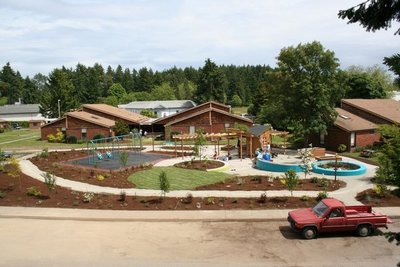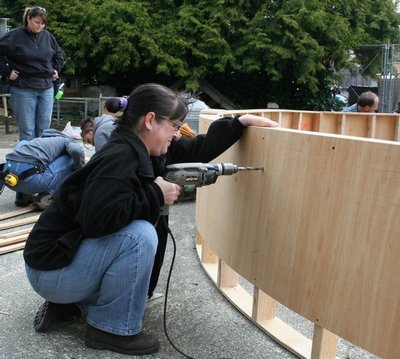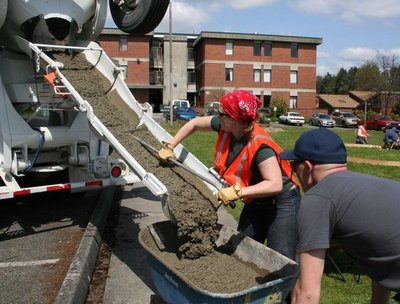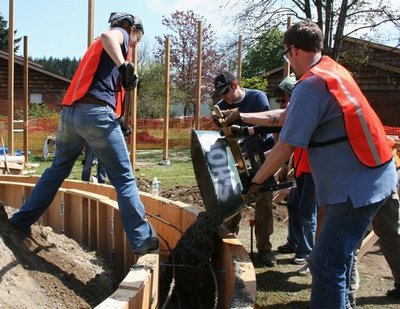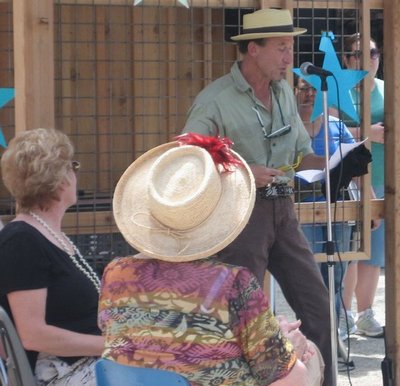July 24, 2008
‘Colorsplash!’ blooms at Fircrest
It all started in 2007 when a resident of Fircrest School wanted to grow pumpkins. Today, those pumpkins are part of a large garden and play space, thanks to students at the UW.
“The pumpkin patch was the kernel that got people thinking,” said Daniel Winterbottom, a UW landscape architecture professor. “Then, representatives of the Fircrest staff and Friends of Fircrest — a nonprofit support group — approached the UW and asked the Therapeutic Garden Design Certificate Program to get involved. People in that program got excited about the project and asked me if I’d take it on as a design/build project.”
Winterbottom agreed, and he and 15 of his students spent 10 weeks building what they have dubbed ColorSplash! Therapy Playground. Created on a quarter-acre parcel once barren except for rickety old play swings and the swamp which appeared during rain showers, the playground is actually a large garden for the approximately 200 Fircrest residents, all of whom have severe developmental disabilities, and their caregivers.
“It’s wonderful. Much nicer than any of us anticipated,” said Asha Singh, superintendent of Fircrest. “Gardening helps our people with such things as physical coordination and sensory stimulation.”
Staff members had also wanted more fresh vegetables for residents, and had discussed expanding the small patch of pumpkins, said Michael Marconi, a Fircrest service coordinator.
The school is in Shoreline across from the Washington State Public Health Laboratory on 15th Avenue NE. Residents have ranged from young children to seniors in their 80s.
New state requirements require multi-age playgrounds at places such as Fircrest, but Friends of Fircrest had long talked about a play space and a garden. They eventually raised $55,000, and partnered with Winterbottom and his students to design the garden. The students both designed and created the garden as a capstone project, a final course for undergraduates in the Landscape Architecture Design/Build Program.
ColorSplash! follows a healing garden at Fircrest for which Winterbottom made the initial arrangements in 2003. Professor John Young and lecturers Roxanne Hamilton, Jim Nicholls and Nhon Trong guided UW students who designed and built that garden — which is located elsewhere on the school’s 84 acres — in 2004.
ColorSplash! is a study in economy, each section with a purpose. For example, a 5-foot-wide outer path encircles the oval parcel, slightly graded on one side to encourage physical effort but flat on the other for wheelchairs or residents who have difficulty walking.
A turn from the outer path leads past scented plants — sage, catnip, lavender — to a trellis and a gathering area which will eventually include a glider swing.
Nearby are multilevel vegetable beds, some with pumpkins for Halloween. Some beds are cantilevered so residents in wheelchairs may garden. A hot turquoise runnel frames the vegetables, catching water from sloped roofs of the garden shed and shelter, which then waters a rain garden. The runnel is also low enough that residents can finger splash.
Past the vegetable patches, the old, beat-up swings have been replaced with a set of safety swings, also in turquoise, and a set of parallel bars good for increasing physical balance. The playground itself is tiled in spongy but solid rubber squares to cushion falls.
But those things are just part of the design, which grew out of a wish list from Fircrest staff and residents as well as Friends of Fircrest.
Becky Chaney, 49, is a landscape architecture student who helped create the garden. She said Fircrest clients often showed up to simply watch. “I learned a lot about Fircrest clients — what they have to offer as people,” Chaney said. “It was obvious that the outdoors is important to them.”
Meantime, Phase II of the garden is the subject of a new wish list. According to Winterbottom and Friends of Fircrest, it might include a treehouse and a sheltered picnic area.
Prof understands power of gardens
For Daniel Winterbottom, a middle-aged Fircrest resident symbolizes the human need for plants and trees. “Day after day she’d sit and watch us create the garden,” recalled Winterbottom. “She could have sat watching television. She could have stared at the walls of her room. Lots of developmentally disabled people do.”
Winterbottom realized the power of gardens when his mother, Miriam Winterbottom, was diagnosed with ovarian cancer in 1989. He spent considerable time with her in various gardens until her death 18 months later. “The gardens nurtured her,” he said.
Winterbottom, now 52, had already become a landscape architect after realizing how well-designed open space can address social needs.
During the spring of 2007, Winterbottom and a group of landscape architecture students redesigned and rebuilt a derelict park south of Seattle in White Center.
Two summers ago in Guatemala, Winterbottom and another group of students designed and built a garden and playground for children whose families live next to the largest garbage dump in Central America. Both children and adults pick through the dump for food and other items they can either use or sell.
In fall 2007, Winterbottom and another group of students designed and built Phase II of the garden. It includes such things as an adventure play structure which weaves through a stand of eucalyptus trees.
The less open, landscaped space underprivileged people have, Winterbottom said, the more they need it. “If one person lives in three houses and another lives next to a garbage dump, access to a garden becomes far more important for the person next to the garbage dump.”
This month, Winterbottom traveled to Bosnia/Herzegovina to discuss a partnership with the Bosnian Community Gardening Association and the American Friends Service Committee. UW landscape architecture students would create two therapeutic gardens for the country, which is still suffering from war in the 1990s.
